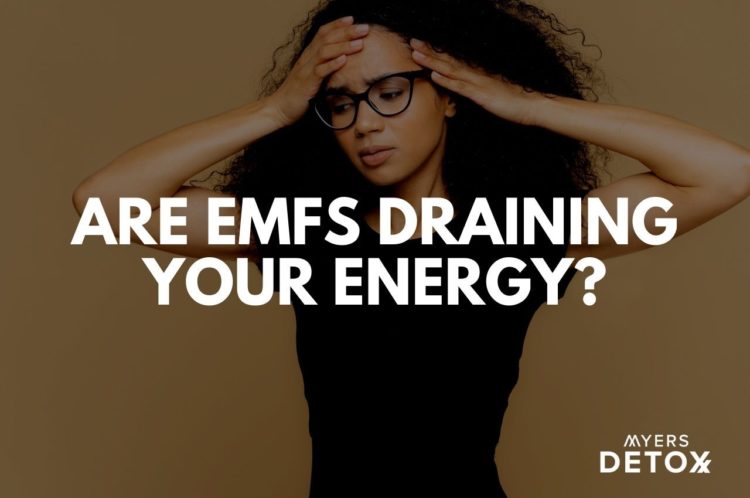Are EMFs Draining Your Energy?

How have your energy levels been lately? If you’ve been feeling extra fatigued, lazy, listless, or just generally tired, there may be a hidden source of stress that’s zapping your energy. Learn more about how EMFs may be draining your energy in this article…
EMFs, or electromagnetic fields, from wireless internet, cell phones, computers and more can impact your body on a cellular level and interfere with your energy production pathways. They also have an effect on your emotional and mental state, which could further drain you of precious energy.
In this article, you’ll learn:
- How EMFs from WiFi and cell phones zap your energy and leave you drained
- Hidden sources of EMFs lurking in your environment
- How EMFs destroy the powerhouse of your cells, the mitochondria
- The dangers of EMFs to both your mind and body
- What you can do to combat the energy-draining effects of EMFs
How Your Body Produces Energy
While it’s well-understood that the food you eat supplies your body with energy, if you really want to dive into how EMFs can affect this process we need to look at the physiology a bit.
To begin, when you consume food, your digestive tract secretes chemicals called enzymes that break down your food into smaller compounds. In the case of protein, it’s broken down into amino acids, for carbohydrates, they become glucose (or similar monomers), and for fat, they can be broken down into fatty acids and another compound called glycerol.
These smaller compounds can then be absorbed by your body and used to rebuild tissues, support your cells, or be converted to energy.
The energy conversion process happens primarily in a part of your cell called the mitochondria, also known as the “powerhouse of the cell.” Through a complex arrangement of chemical reactions, the food molecules that make it to your mitochondria are then converted into energy compounds called ATP.
ATP effectively traps chemical energy and then carries it to your body’s different tissues to be used as needed[1].
Therefore, along with a healthy digestive process, properly functioning mitochondria are crucial for your body’s energy-producing capabilities.
This explanation may seem pretty simple, but the reality is that all of the chemical reactions that it takes to turn food into ATP are actually under the control of several different systems in your body. When these systems fall out of balance, energy production becomes imbalanced, and an immediate result will be an increase in physical and mental fatigue[2].
EMFs In Your Environment
Below our level of awareness, EMFs (electromagnetic fields or frequencies) are continuously streaming through our environment. This is becoming even more disturbing as faster and more advanced EMF technologies roll out, increasing the power of these frequencies that power our devices.
EMFs are nonnative energetic frequencies that make it possible to use modern technology like cell phones and WiFi. The problem is, these harmful fields of energy interact with your own energy field in your body.
Your energy field is where the majority of communication happens in your body. If nonnative fields, like EMF from cell phones or cell phone towers, are near your body, they will interfere in your body’s delicate communication system and cause problems. For instance, EMFs can interfere in and disrupt brain waves.
Additionally, your body has an electrical system. Although it is much more subtle than what you might think of as electricity, the chemical reactions in your body produce small amounts of electricity that help to power up your own cells. Your heart beat creates an electrical pulse.
When your body’s electrical currents come into contact with EMFs, however, it can disturb the normal balance of energy in your body and create imbalances[3]. This can lead to irregular heart beats and disrupt any electrical activity in your body.
Common sources of EMFs include:
- WiFi Internet
- Cell phones
- Computers
- Microwaves
- Powerlines
- Appliances
- Cell Phones towers
- Electricity poles
Even seemingly low-power appliances that need to be plugged in, like lamps and fans, contribute to the EMFs in your environment.
How EMFs Affect Your Ability To Produce Energy
EMFs can have both direct and indirect impacts on your energy. From a physical perspective, they can directly interfere with energy production and inhibit your ability to sleep well, resulting in sluggishness and fatigue.
From a mental/emotional perspective, EMFs can increase stress and lower your mood, which can be both physically and emotionally draining.
Let’s take a deeper look at how EMFs interfere with your natural ability to produce energy.
Lower Cellular Voltage
Every cell in your body is like a little battery, it holds energy. This energy is in the form of an electrical charge that travels throughout your entire system. It allows for communication between cells, and for the distribution of energy to tissues of your body that are in need[21].
As you age, your cells naturally lose some of this electrical charge, like a battery that is slowly wearing out. This is a natural part of the aging process. But it doesn’t have to be. There are many ways to rev up the cells’ voltage.
However, this energy can also become unnaturally disrupted due to EMF radiation, disrupting your cells membrane potential which lowers the voltage that healthy cells typically run on. This leads to disruption of your cells’ normal function[22]
The electrical voltage energy of your cells is separate from the ATP energy you get from your mitochondria. However, when your cellular voltage is low it also powers down mitochondrial function and their ability to produce ATP energy — further draining your body.
What’s more, when your cell voltage is low you draw in less energy and nutrients, which means the cells are not functioning optimally. It’s as if your cells’ batteries become drained, which disrupts communication between cells and tissues.
Damage Mitochondria
As previously mentioned, your mitochondria are crucial components of your body’s energy production system. It is within these tiny cell parts that ATP is synthesized, the molecule which carries energy around your body.
Under EMF exposure, your mitochondria can become damaged. This damage causes leakage of oxygen, which results in excess of reactive oxygen species (ROS). ROS are responsible for oxidative stress in your body. While some oxidative stress is normal, in excess ROS can lead to oxidative damage[4][5].
When these powerhouses in your cells are no longer able to produce as much ATP, you’ll notice a decline in your energy. What’s more, the generation of ROS creates even more imbalances in your body, which require energy to regulate — that’s a double whammy[6].
Disrupt Voltage Gated Calcium Channels
As previously mentioned, your body has its own electrical currents. These currents act on each and every cell in your body through voltage-gated calcium channels (VGCC). VGCCs initiate signals throughout your body and play a role in a wide range of cellular processes.
When your body comes into contact with EMF frequencies, they change the potential (electrical charge) on the membranes of your cells where the VGCCs live. This disrupts the normal function of VGCCs, and causes an influx of calcium into your cells. This influx of calcium and dysregulation of VGCCs can interfere with crucial biological processes[23].
The beating of your heart, and the contraction of your muscles, for example, are just two of the biological processes in which VGCCs play a role [24].
Poor Sleep
Another way that EMFs zap your energy is by disrupting your sleep cycle. They do this by directly affecting something called your circadian rhythm.
Your circadian rhythm is like an internal clock that tells your body when it’s time to wake, sleep, and eat. It works through signals in your environment and hormonal messengers, which direct your physiological functions.
When it comes to sleep, your body relies on the hormone melatonin to help it shut down for the night.
There are many things that can disrupt the natural production of melatonin — but one of the most common is excess light exposure. Not surprisingly, melatonin production is sensitive to daylight. When your body senses a lack of daylight (as the sun goes down), it’s melatonin production should naturally begin to rise[7].
The issue with EMFs, however, is that your body senses these frequencies as light. This means that you could be lying in bed with your lights off and eyes closed, but if EMFs are streaming through your home (like WiFi), your body may still believe that there is sunlight around, and you will struggle to produce melatonin[8][9].
It’s also hypothesized that the harsher frequencies we are coming more and more into contact with, like 5G, are like a jackhammer to the pineal gland, which irritates it and negatively impacts its functions, like producing melatonin[20].
Research suggests that while you sleep, your body’s ATP production increases, which may account for both the mental and physical fatigue many people feel after a poor night of sleep[10][11]. If you’re not getting enough sleep, you’re not regenerating and not creating enough energy for the next day.
Mood Disorders
When you’re feeling low or stressed, one of the first things you may notice is a dip in your energy. It can be exhausting to have an overactive mind or low mood. In fact, fatigue is one of the most common side effects of depression[12].
EMFs can affect the function of neurotransmitters like dopamine and serotonin that are crucial for a stable mood.
Dopamine, also known as the feel-good neurotransmitter, plays a role in your reward system. When your pleasure centers light up, dopamine is stimulated and provides you with a sense of satisfaction.
Serotonin is responsible for providing you with a sense of well-being. It’s also a precursor to melatonin, the sleep hormone, and plays a role in helping your body adapt to stress.
Research shows that EMF exposure can inhibit the production of both of these neurotransmitters. As a result, you may feel a dip in your mood or an increase in stress and anxiety[13][14].
The connection between mood disorders and energy production isn’t well understood. However, some research suggests that serotonin dysregulation, in particular, may play an important role in the severity of fatigue and changes in energy levels[15].
Stress
Emotional stress can be physically draining on your body.
EMFs affect your heart rate variability (HRV) — a physiological marker that researchers often use to determine stress levels. The measure of your HRV gives you an idea of whether you’re in sympathetic or parasympathetic mode[16].
Sympathetic mode, also known as your “fight or flight response,” is the state of your nervous system during stress. This is marked by increases in heart rate and blood flow and decreased appetite and digestion.
Parasympathetic mode, also known as your “rest and digest” response, slows your heart rate, allows for appetite to become active, and provides a generally relaxed sensation to the body.
When you are in sympathetic mode (stress response), your HRV will decrease; when you’re in parasympathetic mode, your HRV will increase. Research shows that EMF exposure causes a decrease to your HRV — indicating higher levels of stress in the body[17][18].
What’s more, research shows that EMF exposure has a stimulating effect on the release of the stress hormone cortisol. Cortisol is typically released when your nervous system shifts into sympathetic mode, once again indicating the effect of EMFs on your body’s stress levels[19].
How To Protect Your Energy By Managing EMF Exposure
If you’ve been feeling sluggish lately, it could be EMFs that are zapping your energy. These frequencies are everywhere in the environment, and the effects they have on your physiology can be incredibly draining.
So what can you do about it?
Reducing EMF exposure in your home is always helpful, but even if you reduce the EMF exposure in your home, you still have to deal with the outside world. EMFs are everywhere in the environment — what are you to do about work, shopping malls, restaurants, and friend’s homes?
I recommend a Harmoni Pendant. The Harmoni Pendant is a wearable pendant that goes with you everywhere. Research shows that it is able to protect the system against the stressful bodily effect of harmful EMFs, on average, by 48%. This personal EMF minimizing pendant travels with you wherever you go, giving you peace of mind that your body is protected to a large degree.
A recent study of the Harmoni Pendant showed that people enjoyed:
- A 530% increase on average in energy
- A 700% improvement on average in their heart rate variability score – a measure of stress
- Enhanced regulation of the body’s autonomic nervous system on average by 310%
- Improved bodily and circadian rhythms by an average of 160%
That’s pretty amazing!!
Designed with the scientific understanding of electromagnetic frequencies and sacred geometry, the Harmoni Pendant can also help you release negative energetic blockages in your field caused by physical and emotional stressors.
This is why we’re hearing thousands of people wearing the Harmoni Pendant report they have better sleep, more energy, feel less stressed and feel less effects from EMF. All with wearing a beautiful piece of functional jewelry.
Again, taking care of your home and the environments that you spend a good deal of time in is crucial in the battle to protect your body against the harmful effects of EMFs. However, this can quickly become complicated, expensive and frustrating. But it’s something that must be addressed.
I advise people to start with a Harmoni Pendant and then graduate to doing other things. So at least they are protected in large part while investing in the learning curve to minimize EMF in their environment.
If you think you are dealing with electrohypersensitivity, there is nothing I recommend higher than regular wearing of a Harmoni Pendant. I’ve worn my Harmoni Pendant for 3 years and I will NEVER take it off (well, except when I shower and sleep)!
Takeaway
We all experience ups and downs with our energy levels, but if you’ve been struggling with your energy lately, it may be time to look at your EMF exposure. These invisible fields could be silently draining your body of energy on a cellular level, as well as a mental/emotional level.
Unfortunately, EMF technology is only on the rise, so it’s up to you if you want to reduce your exposure and increase your defenses. There are plenty of ways to reduce EMF exposure, like turning off your WiFi at night, avoiding BlueTooth technology, and using EMF shielding devices.
However, it may be more practical to begin by working with your own electromagnetic field to diminish EMFs’ effects. The Harmoni Pendant is a fantastic way to protect yourself agains the stressful effects of EMFs on your body, and it can be worn everywhere you go — it doesn’t get more simple than that.
Everyone is exposed to EMFs so it’s a clear, common cause of fatigue. People have differing levels of sensitivity to EMF – some individuals are much more affected than others. But if you’re experiencing fatigue, EMF should be one of the first things that are addressed.
*These statements have not been reviewed by the FDA. The Harmoni Pendant is not designed to treat, cure, or prevent any disease. It is not intended to replace any medication or healing modality prescribed by your medical doctor.
Click Here for References+
-
Alberts, Bruce, et al. “How cells obtain energy from food.” Molecular Biology of the Cell. 4th edition. Garland Science, 2002.
-
https://www.nature.com/scitable/topicpage/mitochondria-14053590/
-
Sun, Zhi-cheng, et al. “Extremely low frequency electromagnetic fields facilitate vesicle endocytosis by increasing presynaptic calcium channel expression at a central synapse.” Scientific reports 6.1 (2016): 1-11.
-
Santini, Silvano Junior, et al. “Role of mitochondria in the oxidative stress induced by electromagnetic fields: focus on reproductive systems.” Oxidative Medicine and Cellular Longevity 2018 (2018).
-
https://faseb.onlinelibrary.wiley.com/doi/abs/10.1096/fasebj.2019.33.1_supplement.lb135
-
Osellame, Laura D., Thomas S. Blacker, and Michael R. Duchen. “Cellular and molecular mechanisms of mitochondrial function.” Best practice & research Clinical endocrinology & metabolism 26.6 (2012): 711-723.
-
Zisapel, Nava. “New perspectives on the role of melatonin in human sleep, circadian rhythms and their regulation.” British journal of pharmacology 175.16 (2018): 3190-3199.
-
Bouché, Nicolas F., and Kevin McConway. “Melatonin Levels and Low‐Frequency Magnetic Fields in Humans and Rats: New Insights From a Bayesian Logistic Regression.” Bioelectromagnetics 40.8 (2019): 539-552
-
Halgamuge, Malka N. “Pineal melatonin level disruption in humans due to electromagnetic fields and ICNIRP limits.” Radiation protection dosimetry 154.4 (2013): 405-416.
-
Dworak, Markus, et al. “Sleep and brain energy levels: ATP changes during sleep.” Journal of Neuroscience 30.26 (2010): 9007-9016.
-
https://www.health.harvard.edu/staying-healthy/refueling-your-energy-levels
-
Targum, Steven D., and Maurizio Fava. “Fatigue as a residual symptom of depression.” Innovations in clinical neuroscience 8.10 (2011): 40.
-
Ismail, S. A., et al. “Effect of exposure to electromagnetic fields (Emfs) on monoamine neurotransmitters of newborn rats.” Biochem Physiol 4.156 (2015): 2.
-
Kim, Ju Hwan, et al. “Decreased dopamine in striatum and difficult locomotor recovery from MPTP insult after exposure to radiofrequency electromagnetic fields.” Scientific reports 9.1 (2019): 1-13.
-
Eshragh, Jasmine, et al. “Associations between neurotransmitter genes and fatigue and energy levels in women after breast cancer surgery.” Journal of pain and symptom management 53.1 (2017): 67-84.
-
Kim, Hye-Geum, et al. “Stress and heart rate variability: a meta-analysis and review of the literature.” Psychiatry investigation 15.3 (2018): 235.
-
https://www.health.harvard.edu/blog/heart-rate-variability-new-way-track-well-2017112212789
-
BÉRES, SZABOLCS, et al. “Cellular phone irradiation of the head affects heart rate variability depending on Inspiration/Expiration ratio.” in vivo 32.5 (2018): 1145-1153.
-
Perov, Sergey, Nina Rubtsova, and Quirino Balzano. “Effects of 171 MHz Low‐Intensity Electromagnetic Field on Glucocorticoid and Mineral Corticoid Activity of the Adrenal Glands of Rats.” Bioelectromagnetics 40.8 (2019): 578-587.
-
Halgamuge, Malka N. “Pineal melatonin level disruption in humans due to electromagnetic fields and ICNIRP limits.” Radiation protection dosimetry 154.4 (2013): 405-416.
-
Perera, Palalle G. Tharushi, et al. “Exposure to high-frequency electromagnetic field triggers rapid uptake of large nanosphere clusters by pheochromocytoma cells.” International journal of nanomedicine 13 (2018): 8429.
-
Pall, Martin L. “Electromagnetic fields act via activation of voltage‐gated calcium channels to produce beneficial or adverse effects.” Journal of cellular and molecular medicine 17.8 (2013): 958-965
-
Van Petegem, F., and D. L. Minor Jr. “The structural biology of voltage-gated calcium channel function and regulation.” (2006): 887-893.








